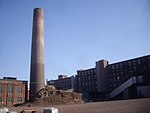William A. Stickel Memorial Bridge

The William A. Stickel Memorial Bridge is a vertical-lift bridge in New Jersey that crosses the Passaic River, connecting Newark and East Newark as part of Interstate 280. The bridge is named in honor of William A. Stickel, a civil engineer from Newark who served as the Essex County engineer for over 20 years.The bridge was constructed from 1948 to 1949 as Route 25A and is owned and operated by the New Jersey Department of Transportation. The total length of the structure is 209.6 metres (688 ft), and it provides a clearance of 11.7–15.1 metres (38–50 ft). The length of the movable section is 41.9 metres (137 ft). The bridge was inaugurated on May 1, 1949, and became part of the interstate system in 1971. The bridge is one of the few movable bridges that remain in the Interstate Highway System. The bridge remained manned by a drawtender until March 3, 1999. It rarely opens and requires 24-hour notice to NJDOT for opening. The six-lane Stickel Bridge has four through-traffic lanes and two lanes for traffic entering and exiting Route 21 at Exit 15 just west of the bridge.
Excerpt from the Wikipedia article William A. Stickel Memorial Bridge (License: CC BY-SA 3.0, Authors, Images).William A. Stickel Memorial Bridge
Essex Freeway,
Geographical coordinates (GPS) Address External links Nearby Places Show on map
Geographical coordinates (GPS)
| Latitude | Longitude |
|---|---|
| N 40.748 ° | E -74.1658 ° |
Address
William A. Stickel Memorial Bridge
Essex Freeway
07029
New Jersey, United States
Open on Google Maps









